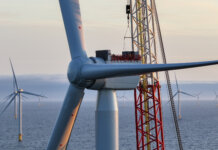Today, around 85% to 90% of wind turbines’ total mass can be recycled. But wind turbine blades present specific challenges. Made from complex composite materials to allow for lighter and more durable blades, they require unique processes for recycling. WindEurope, the European Chemical Industry Council (Cefic) and the European Composites Industry Association (EuCIA) have collected their recommendations for the recycling of wind turbine blades in their recent report Accelerating Wind Turbine Blade Circularity.
“The first generation of wind turbines are now starting to come to the end of their operational life. Many of them will be replaced by modern, more efficient turbines,” says Giles Dickson, CEO of WindEurope.
“We estimate that 14,000 wind turbine blades will be decommissioned in Europe by 2023. The recycling of these old blades is a top priority for us, as we are committed to the principles of a circular economy. Our collaboration with Cefic and EuCIA is key to scaling up the necessary recycling technologies and value chains,” he adds.
The report’s key conclusions include:
- There are various existing technologies to recycle wind turbine blades, but these solutions are not yet all available at industrial-scale and economically competitive.
- The main technology for recycling composite waste is through cement co-processing. WindEurope, Cefic and EuCIA strongly support increasing and improving composite waste recycling through the development of alternative recycling technologies.
- Existing treatment routes such as cement co-processing must be deployed more widely to deal with the growing waste streams.
- Composite recycling is a cross-sector challenge. Active engagement from all the composite-using sectors and authorities is required to develop cost-effective solutions and strong European value chains.
Composite materials are being recycled today through cement co-processing, where the mineral components are reused in the cement and the organic fraction replaces coal as a fuel. Through that process, the CO2 output of the cement manufacturing process can be significantly reduced (up to 16% reduction is possible if composites represent 75% of cement raw materials). Cement co-processing is commercially available for processing large volumes of waste (albeit not in all geographies).
Besides recycling through cement co-processing, alternative technologies like mechanical recycling, solvolysis and pyrolysis are being developed, potentially providing the industry with additional solutions for end-of-life.
To read the Accelerating Wind Turbine Blade Circularity report, click here.





Yes, Europe.
But what about the US, Canada and South America or Taipei?
If “green energy” wants to be “green” and truly respected for being the logical value added choice that it is this ‘little issue’ (a.k.a “recycling”) must be dealt with positively and proactively in every nation on Earth that has such installs. Same for CdTe in solar panels for example.
I wonder whatever happened to the U.N.that we still pay taxpayer dues to? Shouldn’t at least a non-malevolent issue like this be handled in a “world forum” without politicalization?
This world just doesn’t get it…